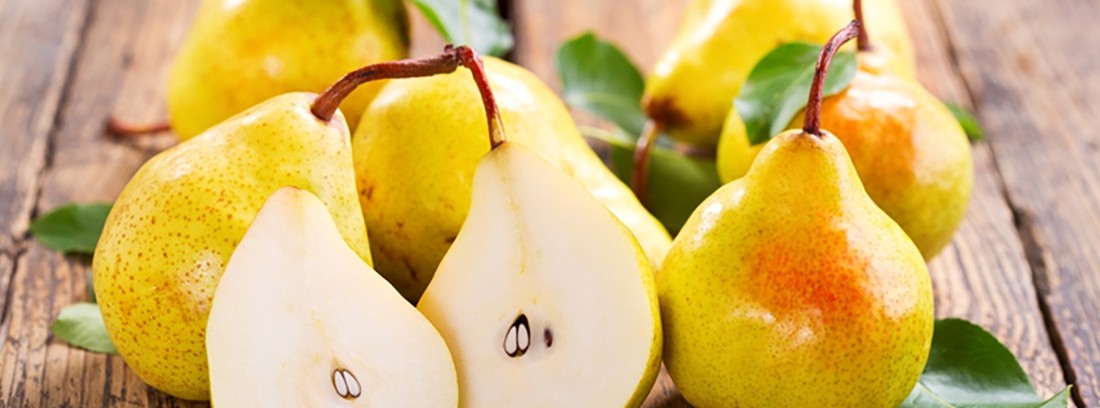Pear: juicy, digestive and diuretic

Fiber, water and tannins
Pear is a fruit that is very rich in fiber (about 2.2 g of fiber per 100 g). Its main component is water, since it contains about 85 g per 100 g, it also provides us with around 10% sugars, 0.4% protein and almost zero fat content.
- As for minerals, we can highlight potassium, and regarding vitamins it does not stand out compared to the content of other fruits richer in vitamin C or carotenoids.
- Pears also contain tannins, tannins are harsh and bitter components that give pears their astringency and antioxidant and anti-inflammatory capacity, especially at the level of the mucous membranes of the digestive tract.
- That is why the pear is included in easily digested diets, it is incorporated as one of the first fruits in the diet of an infant and is still suitable for older people with digestive difficulties.
How to take it
We all know the pear as a fresh fruit as part of a dessert but it can really be given many more applications than simple direct consumption. It can be integrated into first courses such as salads where we can contrast its sweetness with the acidity of lemon or the bitter touch of vinegar. Or also playing to combine its softness with foods of intense flavor such as smoked salmon or blue cheese.
Also in second courses it can be cooked as an accompaniment to meats, especially with red meat or cold cuts, and often with a wine dressing to offer greater contrast. In desserts we can take it in cakes, jams, crepes, in wine, gratin, in mousse, in sponge cake, etc. It is also used to make juices and drinks such as pear cider, typical in certain European regions.
Types of pears
There are a multitude of pear varieties, all of them with differential points that make them especially suitable for some purposes or others. There are pears that are more and less sweet, more and less juicy, with a more grainy texture and a softer texture, etc. The most common varieties for fresh consumption are the Blanquilla pear, the Comice, the Conference, the Anjou, the Bartlett ... Others like the Bosc are more used for cooking, while the Williams is especially suitable for canning.
Who is it good for and who is not?
They are recommended for:
- Digestive difficulties: its composition makes pear an easy to digest food that can be incorporated into the diet from early childhood to old age. Even in cases of diarrhea or gastritis, the anti-inflammatory power of tannins will have a positive effect on the intestinal mucosa.
- As they are rich in fiber and water, they favor intestinal transit, but their tannin content with astringent power somewhat counteracts this effect, causing them to help regulate intestinal transit and to be suitable for both constipation and diarrhea.
- weight loss diets: the main component is water, so they provide less than 40 Kcal per 100 g so they can be part of low-calorie diets.
- Fluid retention and potassium deficiency: due to their potassium content, they contribute to the regulation of body water, preventing fluid retention and promoting diuresis. In the event that potassium has been lost due to episodes of diarrhea or vomiting, or after certain treatments, its consumption will also be adequate.
- and cardiovascular problems: being low in calories, rich in potassium and fiber, etc. their composition makes them perfect to be part of the diet of people with cardiovascular problems and / or high blood pressure.
It is not suitable in case of:
- Renal insufficiency: when it is necessary to control the intake of potassium from the diet, as is the case of some kidney patients, we may have to limit the consumption of pears and other fruits due to their content in this mineral.
Buying and conservation advice
We must discard damaged specimens, which present an excessively soft texture, bad appearance or give off a bad smell. We can detect the ripe pieces as their meat yields under slight pressure with the finger. If they are acquired still hard, their consumption may take more than a week. At home we must keep them in a cool place, protected from light and without wrapping. At an industrial level, they are kept cold and with high humidity and can be kept for more than a month.
Remember thatůPear is a climacteric fruit, that is, it releases ethylene, a gas that favors ripening, so if they are indoors they will ripen more quickly due to the effect of this gas. The same will happen with the fruits that we place next to them.
- Season: as there are many varieties of pear, we have them throughout the year.
- Benefits: it is rich in water, fiber, potassium and tannins. Very versatile and easy to combine.
- Ideal in: easily digestible diets, potassium deficiencies, fluid retention, hypertension.
(Updated at Apr 14 / 2024)